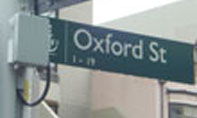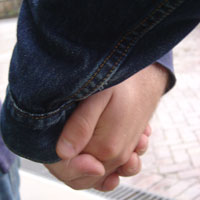- About Us
- Columns
- Letters
- Cartoons
- The Udder Limits
- Archives
- Ezy Reading Archive
- 2024 Cud Archives
- 2023 Cud Archives
- 2022 Cud Archives
- 2021 Cud Archives
- 2020 Cud Archives
- 2015-2019
- 2010-2014
- 2004-2009
 |
(Nov 2004) Gay Time On Prime Time |
It started with a kiss hello. In 1972, the ABC documentary series, Chequerboard screened Peter de Waale greeting his partner Bon Boone with a brief kiss.
Not even noteworthy other than the fact that Bon, too, was a man and the world had just witnessed its first gay kiss on TV. The couple had agreed to come out on air as a political statement but neither the network, nor men involved, predicted Australia's reaction. Bon was immediately fired from his job as a church secretary in North Sydney and he and Peter were appointed as gay rights activism figureheads, a job that consumed their lives for decades afterwards.
If that same footage went to air today, no one would bat an eyelid. After all, a gay kiss is just a kiss now that the public has been desensitised to scenes of same'sex attraction. If audiences want to see men kiss, they need only tune in to Queer As Folk on SBS where protagonist Brian Kinney doesn't just peck hello, his pecker does the helloing, and many times over at that.
So on it goes: Carson chastises another style-strained hetero, Madonna struggles for relevance by tonguing some pop tarts and a gay male duo wins the ABC Strictly Dancing competition, ahead of a lesbian couple.
Whilst today's programs afford the homosexual community some visibility, it's hardly wide'ranging. The Fab Five are slotted straight into the gay man stereotype ' fun, fashionable, fickle ' and the Madonna/Brit/Christina-three-way boils down to performance lesbianism acted out for attention, not attraction.
According to Gay and Lesbian Rights Activist, David McCarthy, it's this portrayal of homosexuality as something to dabble in, or a 'lifestyle choice', that ignores the social, financial and emotional hardships attached to being gay.
It's a concern shared by Gay and Lesbian Rights lobbyist, Catherine Roberts. "The media only focuses on the saucy, sleazy aspects of our community," she said.
 Gay prime time characters have been represented on TV to date as one-dimensional. Jack from Will & Grace is that funny gay guy that everyone can laugh at and Will is that sensitive gay guy that is the perfect male friend. Carol from Friends is merely the butt of tiring jibes from Chandler and Joey and Jack is perpetually unlucky in love in Dawson's Creek. There's a reason for this: none of these gay characters have other permanent cast members with whom they may enter into relationships or sustain an issue-based storyline. Such is the difficulty faced by television producers who must then make entire casts gay (a la Queer As Folk and The L Word) to develop gay characters beyond their sexual identity.
Gay prime time characters have been represented on TV to date as one-dimensional. Jack from Will & Grace is that funny gay guy that everyone can laugh at and Will is that sensitive gay guy that is the perfect male friend. Carol from Friends is merely the butt of tiring jibes from Chandler and Joey and Jack is perpetually unlucky in love in Dawson's Creek. There's a reason for this: none of these gay characters have other permanent cast members with whom they may enter into relationships or sustain an issue-based storyline. Such is the difficulty faced by television producers who must then make entire casts gay (a la Queer As Folk and The L Word) to develop gay characters beyond their sexual identity.
Until recently, the sensibility of the homosexual community was used as an excuse for networks not to include gay representation on TV at all. However, as Queensland University of Technology Media Commentator Brooke Harris noted, homosexual groups have lobbied for more representation as "often, the media is the only source that can allow members of the gay and lesbian community to realise that there are others just like them."
In the US, a surge of advertising revenue has been pumped into the gay press. In 2001, advertising revenue doubled to $208 million from $100 million, four years before. The increase has been attributed in part to the "Will & Grace spill over effect" where an upscale gay male in New York City buys a new product, raves about it to his educated, urban female friend who in turn, influences the purchasing decisions of her affluent friends and their boyfriends. So what begins as a gay-targeted marketing campaign in a gay publication becomes an effective, cheaper way to promote a product in the mainstream.
Despite evidence of successful advertising in a gay-orientated medium, Australian advertisers are proving a little more conservative. When Channel 7 bought into the lust for lesbians with recent series, The L Word which centres around the lives of five hot LA lesbians, major advertisers (including Just Jeans, Allianz, Roche, Centrum and Daimler-Chrysler) pulled their support. This came at the insistence of the Christian right who objected to the show's "immorality". Advertising worries aside, the show has also been criticised for giving a false impression of all lesbians being beautiful. But since when has television shown an accurate cross-section of society?
Not all advertisers are so homophobic. Some are lapping up the money-making opportunities that gay television is creating. For example, Queer Eye, from which an Australian series has been spawned, has been described in New York Magazine as less about the "understanding between homos and heteros. It's about the mutual understanding between Bravo/NBC and Diesel...Robert Cavalli and Ralph Lauren".
Regardless of what has brought about the heightened demand for more gay television, it's here, popular and likely to increase. And while the political struggles that came to the fore with the first representation of Bon and Peter in '72 have been overshadowed by fashion and dollar signs, gay representation on prime time is still stimulating public debate. That discussion might be led for now by John Laws complaining about how boring it is to see "poofs painting a room" on The Block, but it's a start. Gay people on TV have got straight tongues wagging.
